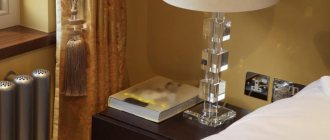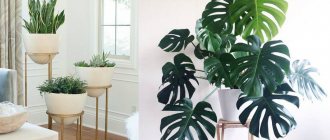For each person, what his or her living room looks like is of particular importance. Therefore, many decorate it with lush greenery using suitable plants for the bedroom. In this room you want to truly relax, reflect on the meaning of life, dream and simply replenish your energy. And indoor flowers tend to have a beneficial effect on the emotional state of household members. With the help of plants for the bedroom, you can create unique compositions reminiscent of the beauty of the natural landscapes outside the window. In addition, greens can purify the air in a closed space. And some specimens have a bactericidal effect. What indoor flowers can be kept in the bedroom without unnecessary worries? Let us consider in detail all the pros and cons, taking into account the individual properties of colors.
On this topic:
A luxurious flower for your flowerpot and more -...
Aug 28, 2020
Large-sized Tradescantia or reo flower - care for...
Aug 28, 2020
Large-sized palm tree for a spacious hall - areca, care in...
Aug 27, 2020
“Live” flower on your window - oxalis, care...
Aug 21, 2020
BACK FORWARD 1 of 16
Some people like to grow a large number of plants in their bedroom. There are no specific rules here, the main thing is that the person has time to take good care of them; water, replant, spray leaf plates in time.
What flowers should not be placed in the bedroom
Large plants should not be allowed into the bedroom, because with the onset of darkness they will begin to consume large amounts of oxygen. Small flowers in a large group will also begin to feed on oxygen.
In general, if you really want to, you can allow yourself to place a couple of flowers in the bedroom, but they need to be placed as far as possible from the bed. These flowers should be soft, delicate, pleasant.
Small flowers in the bedroom
What flowers can you keep in the bedroom?
There are always a lot of problems with choosing flowers, because some flowers are suitable for a given person and they are not suitable for another.
If the bedroom is a shelter for elderly people, then to stabilize the pressure, you can have a mother-in-law tongue in it. It makes the air cleaner, does not absorb, but, on the contrary, releases a lot of oxygen, and even has a strengthening effect on the immune system.
Pelargonium will lull a person to sleep in the bedroom. It should relieve headaches and regulate high blood pressure. Geranium is sometimes unfairly offended, considering it a bourgeois flower. Previously, by the way, they knew that it cleanses the room of unwanted microbes, calms the nerves, improves sleep and normalizes blood pressure.
Flower bouquet in the bedroom
How to choose flowers for the bedroom
Considering everything said above, we can conclude: there should be plants in the room for sleeping, but they should be unpretentious, non-poisonous, healthy and preferably useful flowers for the bedroom without a pronounced aroma. In addition, their appearance should be in harmony with the interior of the room - for many this is also very important.
Despite such a long list of requirements, we have plenty to choose from.
Which plants are the most suitable?
Many home flowers have not only beauty, but also beneficial properties. By releasing oxygen and phytoncides into the air, they clean and disinfect it. It has been noticed that if there are a large number of such plants in the house, its inhabitants are less likely to suffer from colds and flu.
Important! Before buying a plant you like, ask if it can be kept in a house where there are children or pets. Some of them, quite safe as long as they are not touched, can cause serious harm if the juice gets on the skin or mucous membranes.
So, what flowers are most suitable for the bedroom?
- Indoor citrus fruits - tangerine, lemon, calamondin . They have bactericidal properties, calm, and relieve depression. It is believed that they increase the thirst for knowledge, so it is useful to place them in a child’s bedroom. The price of such a tree is quite high, but you can grow it yourself - from a seed.
lemon tree
- Pelargonium (geranium) – saturates the surrounding space with essential oils that relieve negative emotions and soothe.
Even our grandmothers grew this plant; pelargonium could be found in every house.
- Spathiphyllum and chlorophytum are unpretentious plants that absorb harmful substances from the air such as xylene, toluene, formaldehyde, emitted by modern furniture and finishing materials. (See also the article Wallpaper color for the bedroom: how to choose.)
Chlorophytum
Favorable flowers for the bedroom are also eucalyptus, myrtle, rosemary, lavender, mint, and bay tree.
Read also: Flower for the bedroom – choose wisely
Design Tips
Everyone's bedrooms are different in style, design and size.
If you want the flowers in this room to look good, follow these tips:
- A spacious room will be decorated with a large and tall plant in a tub placed on the floor in a well-lit place. It could be a ficus or palm tree. Many small pots of flowers will only create a cluttered effect.
Palm tree in the bedroom
- Aspidistra, sansevieria, cissus and other not too large flowers look great in a medium-sized bedroom. They are, however, too bulky for a windowsill, so choose crops that do well in both sun and shade.
- But it’s best to decorate a small room with small pots of violets, begonias, cyclamen or even cacti placed on the windowsill.
Calathea - keeper of home happiness
- If the walls in the bedroom are covered with bright wallpaper with a pattern, the flowers for this room are selected modest, with plain leaves. And vice versa - variegated plants will look advantageous against the background of plain pastel walls. (See also the article What color to choose wallpaper for the bedroom: features.)
- Flower pots should also match the style of the interior.
Bouquets of flowers in the bedroom
Sometimes, after a walk in the countryside, the hostess returns with a bouquet of flowers. Vivid memories of pleasant things can do a disservice, because fragrant and beautiful flowers in a bouquet worsen your well-being. You cannot place lily of the valley and lilac, chamomile and flowers with thorns and sharp leaves in the bedroom.
If some flowers still grow in the bedroom, you need to monitor their behavior during the week. If a person does not feel any changes for the worse, or there is no reaction at all, then, clearly, the flowers can not be changed to others. Or you can give up the idea of placing them in the bedroom - it’s better to place them in the living room or kitchen.
Useful indoor plants for the bedroom
We have known since childhood that plants are useful.
Remember how back in kindergarten we were taught to care for them, teaching: “They release the oxygen that we breathe.” In addition to this main task, flowers in the house can bring “various benefits”:
- It is beautiful;
- This is useful: they purify the air from hazardous substances, releasing phytoncides;
- Plants also heal: just remember aloe.
We can continue to list the benefits of plants, but our task now is to figure out what are the most useful indoor plants for the bedroom. Let's start with what Feng Shui says about plants.
Earlier on the site we already wrote in detail about how the teaching that has rapidly burst into the lives of Europeans in recent years - Feng Shui - advises placing indoor flowers.
In addition to the fact that supporters of ancient Chinese teachings strongly recommend getting rid of diseased plants that absorb positive energy, they are generally against many plants in the bedroom. For example, those that have sharp leaves or needles.
- You cannot keep plants with needles in residential visits. Therefore, there should be no cacti in the bedroom - the thorns of this plant make the inhabitants of the bedroom prickly and unapproachable. Can this contribute to a warm relationship with your loved one? Do you like cacti? Place them in your office or near your computer.
- If you want to diversify your bedroom interior with indoor plants, then there should be very few of them - no more than 1 - 3 pots, which are located far from the bed. It is desirable that these are the flowers that enhance the feeling of love and mutual understanding. According to Feng Shui, the best indoor plant for the bedroom is one that is red in color. For example, feces. This flower will help avoid conflict situations between spouses.
- You can also place a small ficus in the bedroom. This is especially good for those couples who cannot conceive a baby. According to Feng Shui, by caring for a small ficus, you can adjust the energy of the house for the appearance of a small child.
Indoor flowers are full of variety. But for the bedroom, representatives of green plants, without a large number of flowers and a cloying aroma, are more suitable:
- Chlorophytum is an excellent air humidifier, which is important for dry heating seasons. The plant also purifies the air from harmful gases, gets rid of microorganisms, and acts as a neutralizer of toxic compounds. To completely clean one room, four of these plants are enough.
- Sansevieria or “mother-in-law’s tongue” has many benefits. This plant produces oxygen both day and night; ideally, 8 leaves are enough for everyone present in the bedroom for maximum beneficial effects - strengthening the immune system, stabilizing blood pressure, and fighting headaches. It does an excellent job of filtering harmful substances such as benzene and formaldehyde, which is perfect for city apartments.
- Spathiphyllum or peace lily is a feminine flower for feminine energy. Along with the active production of oxygen, it perfectly humidifies the air, thus neutralizing microbes dangerous to the respiratory tract. This flower is also responsible for normalizing energy. It also perfectly detoxifies alcohols, acetone, ammonia, benzene, and xylene. Spathiphyllum will provide relief during aggressive aromas from neighbors' renovations.
- Ficus neutralizes harmful toxins by releasing phytoncides into the air, which reduces the risk of viral diseases. It humidifies the air well and enriches the room with oxygen. The leaves of the plant trap dust, which can then be easily removed with a damp cloth. From the point of view of Feng Shui, this plant brings peace and tranquility, which is why it is so valuable for the bedroom.
- Ficus benjamina can relieve stress and normalize sleep. Copes perfectly with odors of household chemicals and finishing materials. Enriches the room with oxygen and promotes air humidification.
- Geranium or pelargonium is a carbon monoxide and chemical neutralizer. Saves from staphylococcus and streptococcus. Has a beneficial effect on the nervous system and respiratory organs. The plant goes well with female energy, thereby having a great effect on hormonal levels. The aroma of the flower perfectly repels insects, however, it can also cause allergies, so before purchasing you need to first check for its absence.
- Hamedorea is a plant that saturates the air with ozone, the smell of freshness. Fills the room with oxygen and humidifies the atmosphere. Along with these properties, it does an excellent job of absorbing toxic mixtures and neutralizing benzene and trichlorethylene.
- Chrysanthemum brings the energy of calm. It releases phytoncides and perfectly absorbs household odors such as cigarette smoke, the smell of plastic, and ammonia. neutralizes formaldehyde.
- Violet stabilizes nervous processes. The psycho-emotional impact depends on the color. White flowers ease nervous breakdowns, relieve stress, purple flowers unite, rid the house of negative energy, and red and pink flowers serve as a source of satisfaction and joy.
- Cactus purifies the air well, and the longer the needles, the better for the bedroom. Fights microbes, reduces air ionization, which is the key to protection against electromagnetic waves.
- Dracaena tones and cleanses the energy, while enhancing positive emotions. It humidifies the air well and enriches the space with oxygen.
- Aloe kills bacteria that cause diseases, making the bedroom atmosphere healthier. Two or three plants are able to maintain excellent immunity during the most dangerous periods. It also absorbs toxic substances from chipboard furniture that is harmful to health (up to 90 percent). From a medical point of view, this plant is also unique. The energy of the plant creates protection from misfortunes and removes electrification, while the plant does not like large numbers of people.
- The “Money Tree” is primarily responsible for the material side, and is a symbol of prosperity, accumulating positive energy. Absorbs negative energy, cleansing the space. It can rightly be called a filter plant, as it neutralizes harmful substances and absorbs odors. Releases oxygen well.
- Begonia, like the money tree, is a symbol of prosperity. The aroma helps cope with depression and illness. The flower is especially recommended for the bedroom of an elderly person. Neutralizes harmful microbes.
- Kalanchoe is an antidepressant plant. Actively releases oxygen, helping to humidify the air.
- Palm tree is a wonderful decorative element for the bedroom. Along with beauty, it enriches the room in which it is located with oxygen and humidifies the air. It is a source of energy of freshness and strength.
- Laurel is a versatile plant. Humidifies and purifies the bedroom air. Calms the nervous system, relieves migraines, intestinal spasms, increases blood circulation, which is good for the brain.
- Citrus fruits - lemon, orange, tangerine, lime - all of them have a beneficial effect on the respiratory system and produce healing substances, which have a beneficial effect on the aura of the room. Kill microbes and reduce their reproduction.











